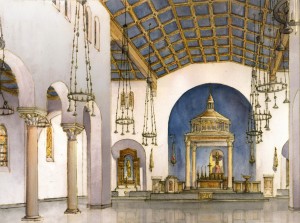
These Christian churches conveyed a sense of direction from the entry through the great West door up the central aisle to the sanctuary with it’s altar and finally up to the tabernacle–the Holy of Holies and the presence of Christ. These Christian churches not only conveyed in architecture the linear view of salvation history, but they also evoked the hierarchical sense of the church. As you moved forward you also moved further up and further in.
All of this is lost in the modern teepee, circus tent sort of church. Tradition was trashed and innovation was in. The architects and designers and liturgists flailed about trying one new idea after another with the result that not only has tradition been trashed, but every new church had to express some trendy new idea or another, or be the vehicle for some architect or poorly trained parish priest to ‘express himself’ or some new idea or enthusiasm.
Another principle from the Book of Exodus corrects this modern mania for self expression. The structure of the tabernacle was given by God. Moses didn’t make it up. Along with the rectangular, three chambered structure, some other principles were also established. The tabernacle was not essentially a meeting place for the people of God. It was first and foremost the dwelling place of God. That the people went there to make sacrifice and worship was incidental. The focus, therefore, was to create a worthy and beautiful dwelling place for the deity. Do you see the difference? We moderns don’t intend to make a temple for God. We intend to make a meeting place for ourselves. No wonder we build auditoria and not temples.
The final principle established in the instructions for the tabernacle rests on the second. If this is the dwelling place for God, then nothing but the best is worthy of his house. We read that the children of Israel brought all the gold and silver that they had plundered in their escape from Egypt and used it to make the golden candlesticks, the gold plated tables, the sacred vessels and the Ark of the Covenant. The women brought their costly fabrics and threads and wove into the panels of the tabernacle exquisite portrayals of angels. The fabric walls themselves were not made from rough wool, but from expensive dolphin hide and rare linens dyed with precious purple and embedded with gems.
No base, utilitarian meeting place with a few tawdry trinkets and decoration thrown in. Instead the tabernacle was a glorious dwelling place for God–an awesome throne room for the Almighty into which his people came to offer their sacrifices of praise.
One of the happier consequences of the teepee churches is that because they were built cheaply and filled with trashy junk no one will feel too bad when they reach the end of their lifespan and are either torn down or turned into the parish meeting hall. They were fashionable buildings of their time–a time when the timeless was dismissed as boring. Consequently, like bell bottoms and double knit leisure suits, when their time is over these inconsequential buildings may be disposed of, and no one will grieve their going. No one will form a committee to petition the bishop to preserve the historic and important church. Instead everyone will breathe a sigh of relief and vote to bring in the demolition team.
Happily a new generation of church architects is even now arising who understand the impact and importance of timeless architecture. Young men and women who understand how tradition can be at once timeless and up to date. These young men and women are determined and intelligent and talented. Furthermore, they are fully Catholic. They are committed to their faith. Undaunted by an architectural establishment that ridicules them because they are threatened by them, they are working quietly and courageously to renew the tradition in our day and age. They wish to build churches that are beautiful tabernacles for God–not just gathering places for his people.
Go here to learn more about the new church we are building at Our Lady of the Rosary parish.